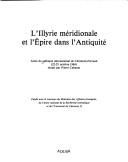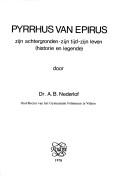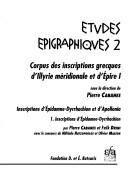| Listing 1 - 10 of 12 | << page >> |
Sort by
|
Book
ISBN: 9788846754158 8846754158 Year: 2018 Publisher: Pisa Edizioni ETS
Abstract | Keywords | Export | Availability | Bookmark
 Loading...
Loading...Choose an application
- Reference Manager
- EndNote
- RefWorks (Direct export to RefWorks)
Epirus (Greece and Albania) --- Antiquities. --- Epir (Greece and Albania) --- Ípiros (Greece and Albania)
Book
ISBN: 090574313X Year: 1989 Publisher: London : Stacey International,
Abstract | Keywords | Export | Availability | Bookmark
 Loading...
Loading...Choose an application
- Reference Manager
- EndNote
- RefWorks (Direct export to RefWorks)
Pyrrhus King of Epirus --- Epirus (Greece and Albania) --- -Epirus (Greece and Albania) --- -Epir (Greece and Albania) --- Ípiros (Greece and Albania) --- History --- Kings and rulers --- -Biography --- Pyrrhus, --- Pirr, --- Pirro, --- Pyrros, --- Epir (Greece and Albania) --- History. --- Biography.

ISBN: 2866390113 9782866390112 Year: 1987 Publisher: Clermont-Ferrand Adosa
Abstract | Keywords | Export | Availability | Bookmark
 Loading...
Loading...Choose an application
- Reference Manager
- EndNote
- RefWorks (Direct export to RefWorks)
Illyria --- Epirus (Greece and Albania) --- History --- Congresses --- Antiquities --- -Illyria --- -Epirus (Greece and Albania) --- -Epir (Greece and Albania) --- Ípiros (Greece and Albania) --- Illyricum --- -Congresses --- -History --- Epir (Greece and Albania) --- Congresses. --- Illyria - History - Congresses --- Illyria - Antiquities - Congresses --- Epirus (Greece and Albania) - History - Congresses --- Epirus (Greece and Albania) - Antiquities - Congresses
Book
ISBN: 2701800757 9782701800752 Year: 1993 Publisher: Paris : De Boccard,
Abstract | Keywords | Export | Availability | Bookmark
 Loading...
Loading...Choose an application
- Reference Manager
- EndNote
- RefWorks (Direct export to RefWorks)
Illyria --- Epirus (Greece and Albania) --- Antiquities --- Congresses --- History --- -Epirus (Greece and Albania) --- -Illyria --- -Illyricum --- Epir (Greece and Albania) --- Ípiros (Greece and Albania) --- -Congresses --- -Antiquities --- Illyricum --- Congresses. --- Illyria - Antiquities - Congresses --- Illyria - History - Congresses --- Epirus (Greece and Albania) - Antiquities - Congresses --- Epirus (Greece and Albania) - History - Congresses --- Antiquités illyriennes --- Antiquités grecques --- Illyrie --- Épire (Grèce) --- Antiquité

ISBN: 9062033008 Year: 1978
Abstract | Keywords | Export | Availability | Bookmark
 Loading...
Loading...Choose an application
- Reference Manager
- EndNote
- RefWorks (Direct export to RefWorks)
Pyrrhus King of Epirus --- Epirus (Greece and Albania) --- -Epirus (Greece and Albania) --- -Epir (Greece and Albania) --- Ípiros (Greece and Albania) --- History --- Kings and rulers --- -Biography --- -History --- Pyrrhus King of Epirus. --- -History. --- -Biography. --- Pyrrhus, --- Pirr, --- Pirro, --- Pyrros, --- Epir (Greece and Albania) --- History. --- Biography.
Book
ISBN: 9782503592619 2503592619 Year: 2020 Publisher: Turnhout: Brepols,
Abstract | Keywords | Export | Availability | Bookmark
 Loading...
Loading...Choose an application
- Reference Manager
- EndNote
- RefWorks (Direct export to RefWorks)
The opening of the borders of Albania in the 1990s stimulated an increased interest in its cultural heritage and led to extensive research, as well as archaeological investigations. These, however, have mainly concentrated within Albania's present-day borders and have lacked broader contextualization. Very recent excavations in Greece, which resulted from the construction of the new Ionia Odos highway, have, however brought to light unexpected and interesting material that changes our image of the monumental topography and the settlements in Epirus. New studies concerning Epirus and its broader connections during the early and later Ottoman periods provide a broader impression of the region and its relationships with the large economic centres of the West, as well as with the spiritual-religious and political centres of the Balkans.
Excavations (Archaeology) --- Architecture, Byzantine --- Church architecture --- Material culture --- Epirus (Greece and Albania) --- Antiquities --- Antiquities. --- Epir (Greece and Albania) --- Ípiros (Greece and Albania) --- History --- Archaeological digs --- Archaeological excavations --- Digs (Archaeology) --- Excavation sites (Archaeology) --- Ruins --- Sites, Excavation (Archaeology) --- Archaeology --- Antiquités byzantines -- Albanie --- Antiquités byzantines -- Grèce --- Épire (Grèce) --- Épire du Nord (Albanie) --- Actes de congrès
Book
ISBN: 2870311559 9782870311554 Year: 1991 Volume: 215 Publisher: Bruxelles Latomus
Abstract | Keywords | Export | Availability | Bookmark
 Loading...
Loading...Choose an application
- Reference Manager
- EndNote
- RefWorks (Direct export to RefWorks)
Geschiedenis van de Oudheid --- Histoire de l'Antiquité --- Musique --- Muziek --- Dionysius, --- Pyrrhus, --- Epirus (Greece and Albania) --- Historiography --- Dionysius of Halicarnassus --- Pyrrhus King of Epirus --- -Epir (Greece and Albania) --- Ípiros (Greece and Albania) --- -Historiography --- Pirr, --- Pirro, --- Pyrros, --- Epir (Greece and Albania) --- Historiography. --- Pyrrhus, - King of Epirus, - 318 BC-272 BC --- Epirus (Greece and Albania) - Historiography --- Dionysios d'halicarnasse --- Rome --- Discours, essais, conferences --- Histoire --- Jusqu'a 30 av. j.-c. --- Pyrrhus, King of Epirus, 318 BC-272 BC

ISBN: 9782869582576 2869582579 2869580762 2869582064 2869580940 9782869582064 9782869582620 2869582625 9782869583214 2869583214 9782869580947 9782869580763 Year: 2020 Volume: 2, 7 Publisher: Athens Ecole Francaise d'Athenes
Abstract | Keywords | Export | Availability | Bookmark
 Loading...
Loading...Choose an application
- Reference Manager
- EndNote
- RefWorks (Direct export to RefWorks)
La 4e de couverture indique : "Après les quatre volumes du Corpus des inscriptions grecques d'Illyrie méridionale et d'Épire (I 1, I 2, II et III) consacrés aux inscriptions grecques d'Albanie, ce nouvel ouvrage présente les inscriptions grecques de Molossie ou de régions extérieures qui concernent des Molosses. Dans une première partie sont rassemblées les sources littéraires grecques et latines qui traitent de la Molossie et notamment de Dodone. La deuxième partie est consacrée à l'histoire de la Molossie et du sanctuaire de Dodone à partir des sources littéraires, archéologiques et épigraphiques. Elle intéresse aussi les régions voisines (Thesprôtie, Cassopie et même la Chaonie unie au royaume des Éacides dès le début du IIIe siècle avant J.-C., puis dans le koinon des Épirotes jusqu'à la catastrophe de 167). La troisième partie du livre rassemble 298 inscriptions de Molossie ou concernant des Molosses dans d'autres région s du monde grec antique, ainsi que quelques documents nouveaux en relation avec les autres régions présentées dans les quatre premiers volumes. Les lamelles oraculaires ne figurent pas dans ce volume. *** Following the four volumes of the Corpus des inscriptions grecques d'Illyrie méridionale et d'Épire (I 1, I 2, II et III) dealing with Greek inscriptions from Albania, this new work presents the Greek inscriptions from Molossia or from other regions related to the Molossians. In the first part the Greek and Latin literary sources are presented, which deal with Molossia and in particular Dodona. The second part covers the history of Molossia and the sanctuary of Dodona from literary, archaeological and epigraphic sources. This part also examines neighbouring regions (Thesprotis, Cassope and even the Chaonians united with the kingdom of the Aiakides from the beginning of the 3rd century BC, then in the koinon of Epirotes until the disaster of 167). The third part of the book b rings together 298 inscriptions from Molossia or concerning Molossians in other regions of the ancient Greek world, as well as some new documents related to the other regions presented in the first four volumes. The oracular lamellae are not included in this volume."
Excavations (Archaeology) - Greece - Thasos Island --- Votive offerings - Greece - Thasos Island --- Inscriptions, Greek --- Inscriptions --- Epigraphs (Inscriptions) --- Epigraphy --- Inscription --- Paleography --- Epigraphists --- Greek inscriptions --- Greek language --- Greek philology --- Epirus (Greece and Albania) --- Illyria --- Epir (Greece and Albania) --- Ípiros (Greece and Albania) --- Illyricum --- Antiquities. --- Fouilles archéologiques --- Ex-voto --- Antiquités grecques --- Antiquités --- Artémis --- Culte. --- Thasos (Grèce ; île) --- Thasos (Grèce) --- Artémision. --- Inscriptions grecques --- Noms de personnes --- Monnaies grecques --- Albanie --- Illyrian antiquities --- Antiquités illyriennes --- Epire (Grèce et Albanie) --- Antiquities --- Antiquités --- Excavations (Archaeology) --- Votive offerings --- Fouilles (Archéologie) --- Catalogs --- Catalogues --- Sanctuary of Artemis (Thasos Island, Greece) --- Thasos Island (Greece) --- Thásos (Grèce : Ile)
Book
ISBN: 190849347X 9781908493477 9780199754151 0199754152 9780199754168 0199754160 9781904955658 1904955657 Year: 2010 Publisher: New York, N.Y. Oxford University Press
Abstract | Keywords | Export | Availability | Bookmark
 Loading...
Loading...Choose an application
- Reference Manager
- EndNote
- RefWorks (Direct export to RefWorks)
Scattered off the west coast of mainland Greece are the seven Ionian Islands, celebrated for their spectacular landscapes, olive groves and classical associations. Together with the mountainous mainland region of Epirus, the combined populations of Corfu, Paxos, Lefkas, Ithaca, Kefalonia, Zakynthos and Kythira constitute less than a twentieth of the population of Greece, yet they have made a huge contribution to the culture of the country, before and since becoming part of the Greek state. T...
Ionian Islands (Greece) --- Corfu Island (Greece) --- Epirus (Greece and Albania) --- Epir (Greece and Albania) --- Ípiros (Greece and Albania) --- Corcyra Island (Greece) --- Kérkira Island (Greece) --- Nísos Kérkira (Greece) --- Heptanesus (Greece) --- Ionia Islands (Greece) --- Ionia Nēsia (Greece) --- Ionía Nísia (Greece) --- Iónii Nísi (Greece) --- Iónioi Nísoi (Greece) --- Periféreia Ioníon Níson (Greece) --- Periphereia Ioniōn Nēsōn (Greece) --- Region of Ionian Islands (Greece) --- Seven Islands (Greece) --- History. --- Social life and customs. --- Description and travel. --- Description and travel --- Regional documentation --- History of civilization --- Epirus --- Ionian islands --- cultuurgeschiedenis
Book
ISBN: 9782728310975 2728310971 272831098X Year: 2016 Volume: 513 Publisher: Rome : École Française de Rome,
Abstract | Keywords | Export | Availability | Bookmark
 Loading...
Loading...Choose an application
- Reference Manager
- EndNote
- RefWorks (Direct export to RefWorks)
La romanisation représente pour les archéologues une question complexe qui touche tant à la notion d'identité qu'aux problèmes inhérents à l'interprétation des témoins de la culture matérielle. Durant les vingt dernières années, l'étude de la romanisation s?est enrichie de bon nombre de publications importantes traitant de presque toutes les provinces de l'Empire romain, marquant une avancée significative dans l'élucidation des modalités diverses de ce processus. Le territoire retenu comme objet d'étude par le présent travail se situe à la charnière des provinces balkano-danubiennes et grecques. Le matériel archéologique disponible, à la fois volumineux et diversifié (monnaies, céramiques, inscriptions), confronté aux structures urbaines mises à jour par les fouilles et à la dynamique de l'habitat rural permet d'éclairer d'un jour nouveau bien des composantes de la vie quotidienne durant la période romaine.
Romans --- Romains --- Illyria --- Epirus (Greece and Albania) --- Albania --- Illyrie --- Epire (Grèce et Albanie) --- Albanie --- Antiquities, Roman --- Antiquités romaines --- Antiquities, Roman. --- Civilization --- Roman influences. --- Roman influences --- Epire (Grèce et Albanie) --- Antiquités romaines --- Romanisation --- Inscriptions --- Coins --- Pottery --- Antiquities. --- Classical antiquities. --- Coins. --- Inscriptions. --- Pottery. --- Romans. --- Rome --- Europe --- Rome (Empire) --- History, Military. --- Antiquities --- Classical antiquities --- Ceramic art --- Ceramics (Art) --- Chinaware --- Crockery --- Earthenware --- Pottery, Primitive --- Ceramics --- Decorative arts --- House furnishings --- Firing (Ceramics) --- Saggers --- Money --- Numismatics --- Epigraphs (Inscriptions) --- Epigraphy --- Inscription --- Paleography --- Epigraphists --- Ethnology --- Italic peoples --- Latini (Italic people) --- Epir (Greece and Albania) --- Ípiros (Greece and Albania) --- Illyricum --- Illyria - Antiquities, Roman --- Epirus (Greece and Albania) - Antiquities, Roman. --- Illyria - Civilization - Roman influences. --- Epirus (Greece and Albania) - Civilization - Roman influences --- archéologie romaine
| Listing 1 - 10 of 12 | << page >> |
Sort by
|

 Search
Search Feedback
Feedback About UniCat
About UniCat  Help
Help News
News